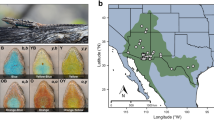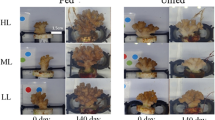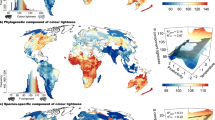Abstract
Brown shelled morphs of Arianta arbustorum are more frequent in shaded woodland than in open, sunnier habitats. This is thought to be the result of selective visual predation (Parkin, 1971). Yellow shelled morphs have a higher metabolic rate than browns, especially at high temperatures, and remain more exposed to sunlight. These non-visual differences in metabolism and behaviour will offset differences in radiant heat gain which result from the two shell colours in open habitats. Differences in heat gain will seldom occur in shaded habitats. The non-visual differences therefore appear to adjust for differences in energy gain caused by shell colour, rather than to act as component forces generating the polymorphism. They therefore do not have a balancing effect.
Similar content being viewed by others
Article PDF
References
Abdel-Rehim, A H. 1983a. Ph.D. Thesis, University of Manchester.
Abdel-Rehim, A H. 1983b. Differences in habitat selection by different morphs of the snail Arianta arbustorum. Biol J Linn Soc, 20, 185–193.
Abdel-Rehim, A H. 1984a. The effects of temperature and humidity on the nocturnal activity of different shell colour morphs of the land snail Arianta arbustorum. Biol J Linn Soc, 20, 385–395.
Abdel-Rehim, A H. 1984b. Metabolic adaptation in the polymorphic land snail Arianta arbustorum. J moll Stud, 50, 96–103.
Cain, A J. Cameron, R A D, and Parkin, D T. 1969. Ecology and variation of some helicid snails in northern Scotland. Proc malac Soc Lond, 38, 269–299.
Clarke, B C. Arthur, W. Horsley, D T, and Parkin, D T. 1978. Genetic variation and natural selection in pulmonate molluscs. In Fretter, V. and Peake, J. (eds.) Pulmonates, vol. 2A. Academic Press, New York.
Cook, L M, and King, J M B. 1966. Some data on the genetics of shell-character polymorphism in the snail Arianta arbustorum. Genetics, S3, 415–425.
Heath, D J. 1975. Colour, sunlight and internal temperature in the land snail Cepaea nemoralis (L.). Oecologia, Berlin, 19, 29–38.
Jones, J S. 1973. Ecological genetics and natural selection in molluscs. Science, 182, 546–552.
Jones, J S, Leith, B H, and Rawlings, P. 1977. Polymorphism in Cepaea: a problem with too many solutions? Ann Rev Ecol Syst, 8, 109–143.
Ochman, H, Jones, J S, and Selander, R K. 1983. Molecualr area effects in Cepaea. Proc Natl Acad Sci, USA, 80, 4189–4193.
Parkin, D T. 1971. Visual selection in the land snail Arianta arbustorum. Heredity, 26, 35–47.
Parkin, D T. 1972. Climatic selection in the land snail Arianta arbustorum in Derbyshire, England. Heredity, 28, 49–56.
Selander, R K, and Ochman, H. 1983. The genetic structure of populations as illustrated by molluscs. In Isozymes: Current Topics in biological and Medical Research, 10, 93–123.
Steigen, A L. 1979. Temperature effects on energy metabolism in banded and unbanded morphs of the snail Cepaea hortensis Müll. Oecologia, Berlin, 41, 163–173.
Tilling, S M. 1983. An experimental investigation of the behaviour and mortality of artificial and natural morphs of Cepaea nemoralis (L.). Biol J Linn Soc, 19, 35–50.
Author information
Authors and Affiliations
Rights and permissions
About this article
Cite this article
Abdel-Rehim, A., Bailey, S. & Cook, L. Non-visual differences between colour morphs of the polymorphic snail Arianta arbustorum. Heredity 54, 251–254 (1985). https://doi.org/10.1038/hdy.1985.33
Received:
Issue date:
DOI: https://doi.org/10.1038/hdy.1985.33



